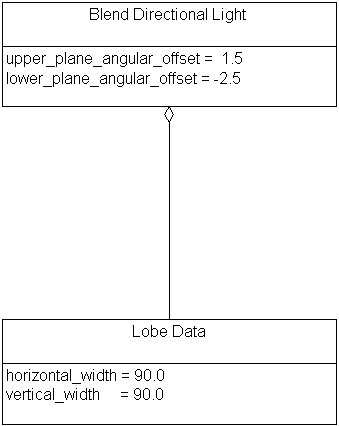Consider a <Blend Directional Light> instance with both a primary and a secondary colour.

At 10 π / 180.0 radians from the SE_REF_VEC_TYP_LIGHT_DIRECTION vector in the vertical direction, towards the positive end of the SE_REF_VEC_TYP_VERTICAL_AXIS vector, the primary colour is visible, because the position lies in the upper section of the pyramid, inside the lobe.
At 10 π / 180.0 radians from the SE_REF_VEC_TYP_LIGHT_DIRECTION vector in the vertical direction, towards the positive end of the SE_REF_VEC_TYP_VERTICAL_AXIS vector, the primary colour is visible, because the position lies at the upper edge of the blend section. Moving from this position along the SE_REF_VEC_TYP_VERTICAL_AXIS vector toward the negative end, the amount of primary colour decreases as it is blended with proportionally increasing amounts of the secondary colour, because this lies within the blend section of the pyramid, from the upper edge to the lower edge. At -0.5 π / 180.0 radians from the SE_REF_VEC_TYP_LIGHT_DIRECTION vector in the vertical direction (that is, towards the negative direction of the vertical axis), the primary and secondary colours are blended in equal amounts, since this position is in the middle of the blend section. Moving in the same direction, the amount of primary colour continues to decrease proportionally as the amount of secondary colour increases. At -2.5 π / 180.0 radians from the light direction, only the secondary colour is visible, as this is the lower edge of the blend section.
At -10 π / 180.0 radians from the SE_REF_VEC_TYP_LIGHT_DIRECTION vector in the vertical direction, that is, towards the negative end of the SE_REF_VEC_TYP_VERTICAL_AXIS vector, the secondary colour is visible, as this lies in the lower section of the pyramid.
At -50 π / 180.0 radians from the SE_REF_VEC_TYP_LIGHT_DIRECTION vector in the vertical direction, that is, towards the negative end of the SE_REF_VEC_TYP_VERTICAL_AXIS vector, nothing is visible, since this lies outside the pyramid.